The Patriot Hellfire M.2 480GB Review: Phison NVMe Tested
by Billy Tallis on February 10, 2017 8:30 AM ESTSequential Read Performance
The sequential read test requests 128kB blocks and tests queue depths ranging from 1 to 32. The queue depth is doubled every three minutes, for a total test duration of 18 minutes. The test spans the entire drive, and the drive is filled before the test begins. The primary score we report is an average of performances at queue depths 1, 2 and 4, as client usage typically consists mostly of low queue depth operations.
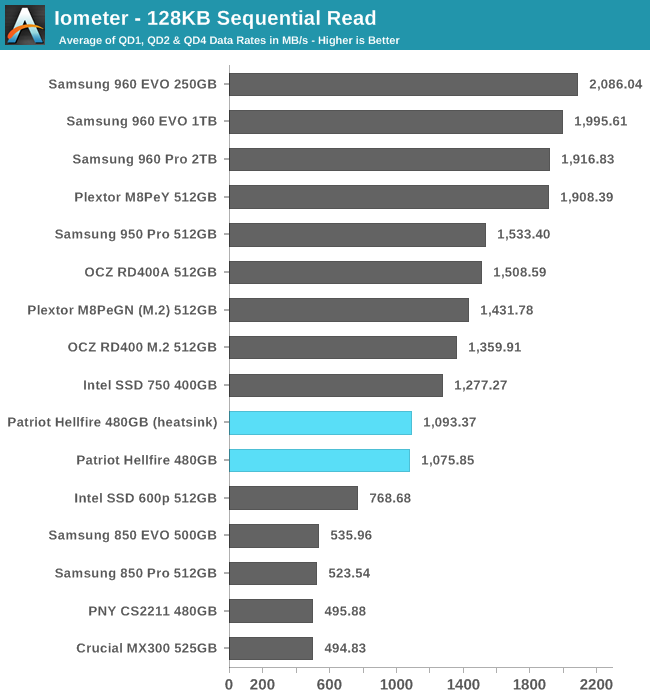
The sequential read speeds of the Patriot Hellfire are clearly slower than almost every other NVMe SSD, but it's still twice as fast as SATA SSDs. The TLC-based Intel SSD 600p falls in between the SATA SSDs and the Patriot Hellfire.
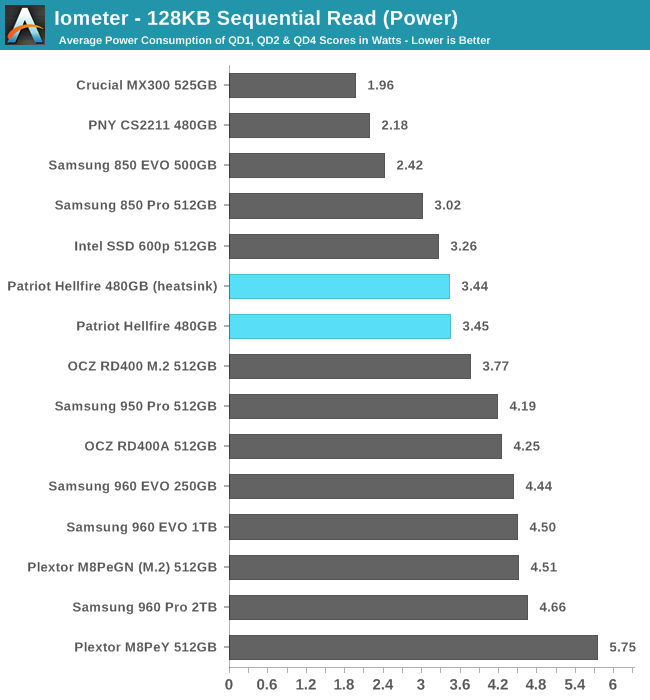
The Patriot Hellfire is also one of the lowest-power NVMe SSDs during sequential reads, so its efficiency isn't particularly poor for this test.
 |
|||||||||
Near the end of the sequential read test the Patriot Hellfire's performance falters as it hits thermal limits, but the addition of a heatsink allows it to eventually catch up to the performance levels most other NVMe SSDs hit at much lower queue depths.
Sequential Write Performance
The sequential write test writes 128kB blocks and tests queue depths ranging from 1 to 32. The queue depth is doubled every three minutes, for a total test duration of 18 minutes. The test spans the entire drive, and the drive is filled before the test begins. The primary score we report is an average of performances at queue depths 1, 2 and 4, as client usage typically consists mostly of low queue depth operations.
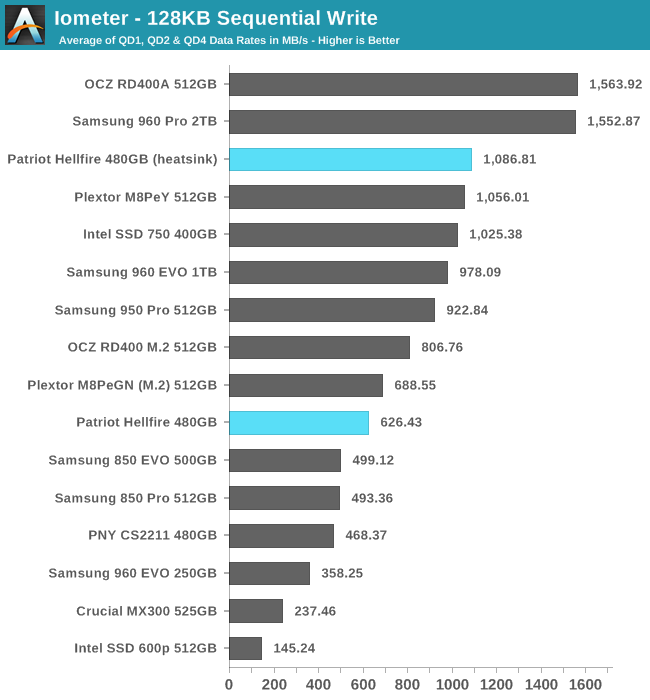
The heatsink makes a huge difference to the Patriot Hellfire's sustained sequential write performance, allowing it to pull slightly ahead of the Plextor M8PeY, but still leaving it far behind the OCZ RD400A.
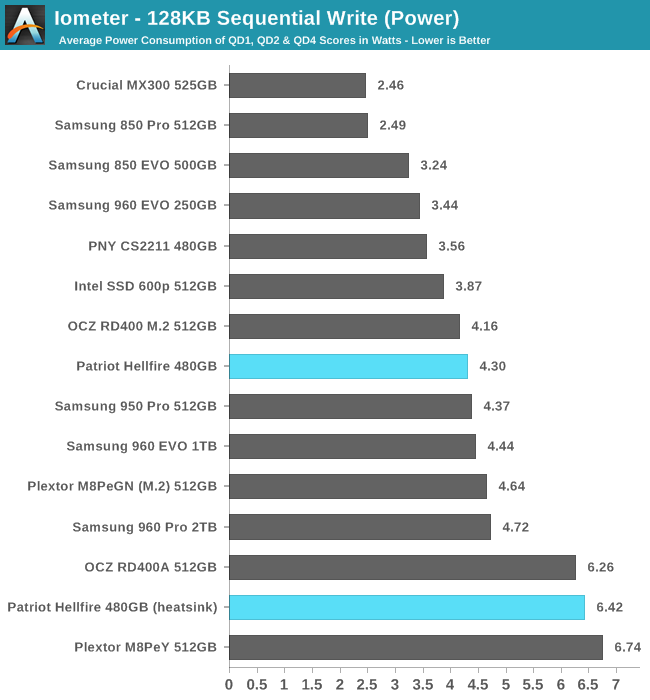
The Patriot Hellfire's efficiency is worse than its competition both with and without a heatsink attached. With a heatsink, it hits the highest power draw of any SSD in this bunch, after discounting the power used by the M8PeY's LEDs.
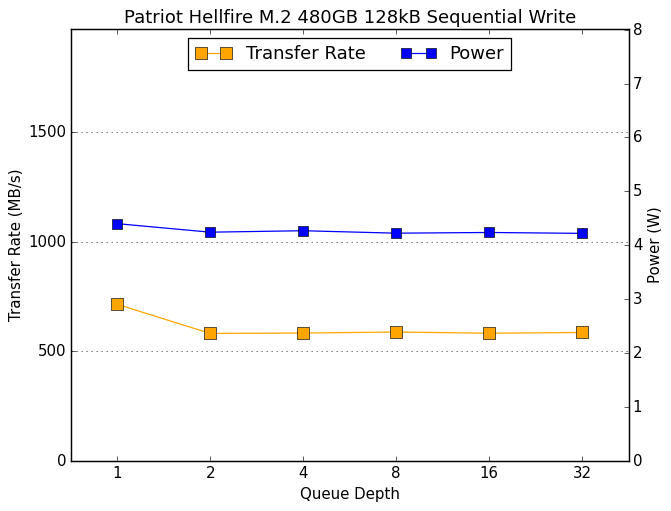 |
|||||||||
Without a heatsink, the Patriot Hellfire is thermally limited by the end of the QD1 test phase, and performance is completely flat for the rest of the test. With a heatsink, the performance scales substantially from QD1 to QD4 before reaching thermal limits.










43 Comments
View All Comments
bug77 - Friday, February 10, 2017 - link
Patriot Minuteman! :DYaldabaoth - Friday, February 10, 2017 - link
Perhaps they are referring to the thermal characteristics.lmcd - Saturday, February 11, 2017 - link
"Logged in just to upvote this" -- comment systems in 2000extide - Saturday, February 11, 2017 - link
ehh back in that era "upvoting" wasn't a thing -- people would just say "this" or "x2"romrunning - Friday, February 10, 2017 - link
Looking at its performance, they should have named it the "Campfire"! :)BurntMyBacon - Monday, February 13, 2017 - link
I'm going to go with "Stinger" ... to keep consistent with the missile theme.Who is it that's getting stung again?
random2 - Sunday, February 12, 2017 - link
You got it. Seems kind of odd that a teck company marketing a retail product would use a naming convention associated with weapons being used around the world to kill and maim people. Wanna keep the politics away from your business? I vote with my dollar.Holliday75 - Monday, February 13, 2017 - link
We should petition the Pentagon to request they stop this practice of buying weapons with mean names as well. The Hellfire seems like a great platform, but we do not like the name. Call it Fluffy Kittens and we'll purchase 10,00 of them.Stas - Monday, February 20, 2017 - link
triggered?Gothmoth - Friday, February 10, 2017 - link
samsung all the way.. this stuff is just for cheapos.....